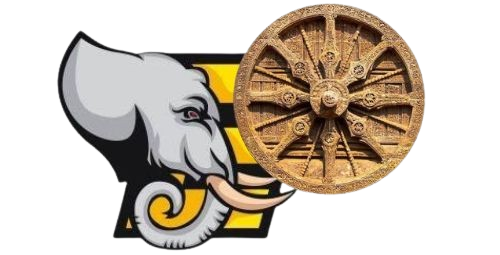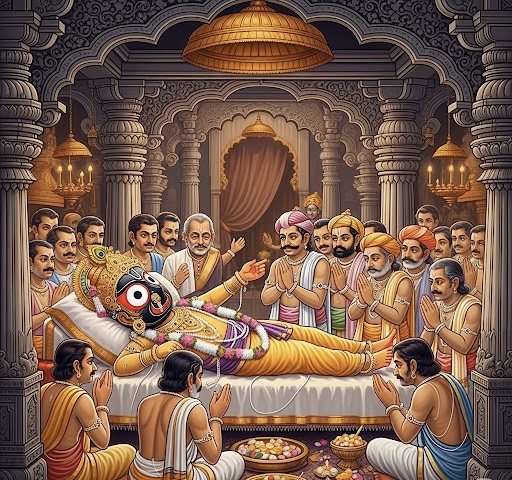Among the myriad of divine traditions observed in India, the rituals associated with Lord Jagannath of Puri stand out for their depth, devotion, and mystery. One such fascinating and spiritually significant event is the period of illness experienced by Lord Jagannath, observed annually just before the world-famous Rath Yatra. This event is not symbolic in a metaphorical sense alone; rather, it is treated with such authenticity that it evokes the deepest emotions of love, care, and devotion among millions of devotees.
In this article, we explore the history behind this divine ailment, the traditional “treatment” administered to the Lord, and what happens during and after his recovery—an intricate and sacred ritual known as “Anasara”.
The Historical and Spiritual Background of the Divine Illness
The concept of Lord Jagannath falling ill finds its roots in centuries-old tradition. Every year, after the ritualistic bath known as Snana Purnima—which falls on the full moon day of the Hindu month Jyestha (May–June)—the deities of Jagannath, Balabhadra, and Subhadra are given a ceremonial bath with 108 pots of sacred water from the golden well inside the temple complex. This sacred bath is part of the cleansing and purification ritual and symbolizes the beginning of preparations for the Rath Yatra.
However, following this elaborate bathing ritual, the deities are believed to “catch a fever”, much like human beings. It is said that the sudden exposure to large quantities of cold water leads to their illness. From this point onwards, a fascinating sequence of divine caregiving begins.
This tradition reflects an anthropomorphic view of divinity—treating the deities not just as gods but also as family members, kings, and beings capable of human-like emotions and conditions. It adds to the richness of Jagannath culture, making the god accessible and relatable.
Anasara: The Divine Rest Period
Following Snana Purnima, the deities are moved to a special chamber inside the temple known as the Anasara Ghar (meaning the ‘Quarantine Chamber’ or ‘Sick Room’). This marks the beginning of the Anasara period, which lasts for 15 days. During this time, the main idols remain hidden from public view. The temple doors are closed to devotees, and no darshan (sight) of the deities is allowed.
During this period of seclusion, it is believed that the deities are resting and undergoing treatment administered by the Raj Vaidya, the royal physician. The temple servitors, particularly those belonging to the Daitapati clan—who consider themselves descendants of the tribal guardians of the Lord—take charge of the treatment and care.
Treatment Details: Ayurveda and Ritual Care
The divine treatment during Anasara is a unique blend of Ayurvedic knowledge and ritualistic devotion. The following practices are part of this spiritual caregiving:
1. Herbal Medication
The deities are believed to be given Ayurvedic herbs and medicines to cure their fever. The main ingredient is a herbal paste called Dasamula, made from ten medicinal roots. The paste is applied as part of the treatment and also forms the base for sacred drinks offered during this time.
2. Dietary Adjustments
The diet of the Lord also changes during Anasara. Instead of the usual Mahaprasad, the deities are offered light and easily digestible food items like Pana (medicated drinks), fruit juices, and boiled preparations, similar to the dietary restrictions followed during a real illness.
3. Patti Dian (Substitute Idols)
Since the original idols are under recovery and not available for darshan, the devotees worship Patti Dian, which are painted images of the deities on cloth. These are placed in a separate area for public worship, ensuring the spiritual connection remains unbroken.
Rituals and Duties of the Daitapatis
The Daitapatis play a pivotal role during this time. As traditional servitors and guardians of the deity, their responsibility increases significantly. Their duties include:
- Guarding the Anasara Ghar, where even other temple priests are not allowed.
- Administering herbal concoctions, cleaning the chamber, and maintaining a sacred and healing atmosphere.
- Performing secret rituals, passed down orally through generations.
This period also reflects the tribal roots of Jagannath worship, where the god is not treated as a distant celestial being but as one of their own—a member of the community in need of care and rest.
After Recovery: Netrotsav and Nava Yauvan Darshan
After the completion of the Anasara period, the Lord is believed to recover from illness. The next event is the Netrotsav (Festival of the Eyes), a very intimate and spiritual ceremony held one day before the Rath Yatra.
During Netrotsav, a special ritual known as Nayan Besa is conducted. The priests repaint the eyes of the deities, giving them a fresh youthful appearance. This ceremony is symbolic of the Lord regaining his vision and youth after recovery. Following this, the deities are presented to the public in their Nava Yauvana Vesha—meaning the New Youthful Form.
This is the first public appearance of Lord Jagannath after 15 days of seclusion and is attended by thousands of emotional devotees who long to see their beloved deity’s “rejuvenated” form.
Rath Yatra: The Grand Journey Begins
Soon after recovery, the Lord, along with Balabhadra and Subhadra, embarks on the world-famous Rath Yatra or Chariot Festival. This annual journey marks the transition from seclusion to public celebration. It is as though the deities are fully healed and now ready to meet their devotees outside the temple walls.
The festival itself is a symbol of divine outreach, where the gods come out of their sanctum to mingle with devotees of all castes, classes, and regions. The sequence—from Snana Purnima to Anasara, to recovery and Rath Yatra—is a spiritual drama that touches the core of millions and deepens their bond with Lord Jagannath.
Symbolism and Spiritual Significance
The illness of Lord Jagannath is not just a ritual—it is rich with symbolism. It reminds devotees that even the divine must undergo cycles of rest and renewal. It reinforces the human connection with divinity, where gods share in the physical realities of their devotees’ lives.
Moreover, it teaches the importance of patience, healing, and care. For devotees, it becomes a time of introspection, waiting, and building anticipation for the Lord’s grand return. The whole sequence is a deeply emotional and spiritual journey, making Lord Jagannath one of the most beloved deities in the Hindu pantheon.
Conclusion
The annual illness of Lord Jagannath and the rituals associated with his treatment and recovery are more than religious traditions—they are profound expressions of love, care, and devotion. This sacred event blends medicine, mythology, spirituality, and community into a divine narrative that is unique to Odisha’s cultural fabric.
Through rituals like Anasara and Netrotsav, devotees witness the vulnerability and strength of their Lord, which in turn strengthens their own faith. The story of Lord Jagannath’s illness is ultimately a story of restoration, renewal, and rejoicing, reminding the world that even the divine rests before embarking on a new journey.


